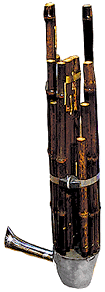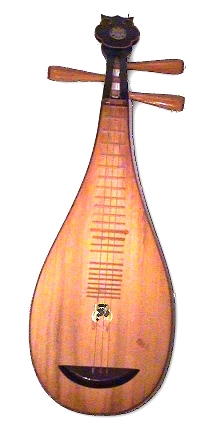|

Far-Eastern Musical Instruments

Lu
Sheng

A sheng is a musical wooden
Chinese wind instrument
wind instrument ,
usually consisting of 17 bamboo pipes set in a small wind-chest into which
one blows through a mouthpiece. Usually tuned in a pentatonic scale ,
usually consisting of 17 bamboo pipes set in a small wind-chest into which
one blows through a mouthpiece. Usually tuned in a pentatonic scale .
In the 18 century, a sheng was taken to Russia .
In the 18 century, a sheng was taken to Russia and evolved into such instruments as the harmonica
and evolved into such instruments as the harmonica ,
concertina ,
concertina ,
harmonium ,
harmonium ,
and accordion ,
and accordion . .

Shakuachi

Japanese end-blown flute, vertical bamboo pipe, with unknown origin. Usually played
as a solo instrument or accompanied by other Japanese traditional instruments,
such as the shamisen
end-blown flute, vertical bamboo pipe, with unknown origin. Usually played
as a solo instrument or accompanied by other Japanese traditional instruments,
such as the shamisen or koto
or koto .
It has 4 front fingerholes and a rear thumbhole. .
It has 4 front fingerholes and a rear thumbhole.

Koto
 
Originated in China ,
during the 8th Century, the koto, a string instrument of the Zither family,
is regarded as Japan's ,
during the 8th Century, the koto, a string instrument of the Zither family,
is regarded as Japan's national instrument. In the past, the Koto was being used to entertain
officials in the Japanese royal court. Nowadays, it is used for both accompaniment
and solo performance in all levels of society.
national instrument. In the past, the Koto was being used to entertain
officials in the Japanese royal court. Nowadays, it is used for both accompaniment
and solo performance in all levels of society.

Pipa

The pipa is a Chinese short-necked lute
short-necked lute and goes back more than 2000 years, probably
originating in Central Asia.
It has 4 silk strings and 19 to 26 bamboo frets glued to the belly of the
lute. It is held vertically and plucked with fingernails. In the past,
the pipa was used for court entertainment.
and goes back more than 2000 years, probably
originating in Central Asia.
It has 4 silk strings and 19 to 26 bamboo frets glued to the belly of the
lute. It is held vertically and plucked with fingernails. In the past,
the pipa was used for court entertainment.

Yuet Chin

Fretted instrument from China ,
also called 'The Moon Guitar'. It has 4 silk metal strings and bamboo frets
on both neck and soundboard. Used to accompany singers, as an ensemble
instrument and in the traditional Chinese
opera of Peking. ,
also called 'The Moon Guitar'. It has 4 silk metal strings and bamboo frets
on both neck and soundboard. Used to accompany singers, as an ensemble
instrument and in the traditional Chinese
opera of Peking.

Sanxian,
Shamisen

This is a 3-string plucked instrument with snake skin heads and long
wooden neck. The strings are plucked with fingernails of the right hand.
Mostly used for accompanying singing. In Japan
instrument with snake skin heads and long
wooden neck. The strings are plucked with fingernails of the right hand.
Mostly used for accompanying singing. In Japan ,
the Chinese ,
the Chinese sanxian is also known as shamisen.
sanxian is also known as shamisen.

Morin Chur

The Morin chur (mongol. "horse
sounds") is the national instrument of Mongolia and one of its musical
symbols. It owes the name of "horse sounds" or "horse head
fiddle" to the carved horse head at the end of its long narrow neck.
The Morin chur is a 2-horsehair string plucked instrument with a trapezoid body. Mostly used
for accompanying the singing of the South-Siberian folk singers of the
Tuva, which imitates tones of nature
instrument with a trapezoid body. Mostly used
for accompanying the singing of the South-Siberian folk singers of the
Tuva, which imitates tones of nature and expresses their deep solidarity with their natural environment.
and expresses their deep solidarity with their natural environment.

Images and sounds courtesy of



MusixCool© By
Nadav Dafni
|